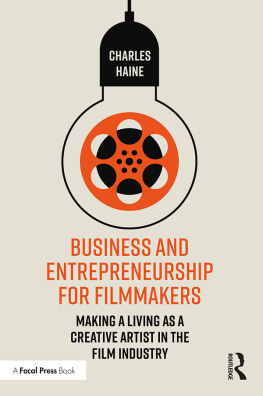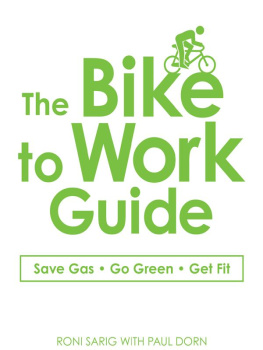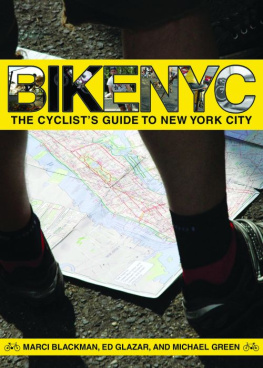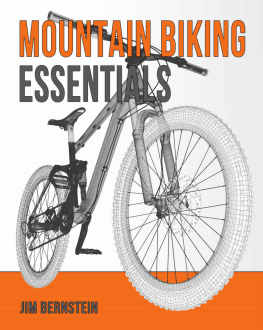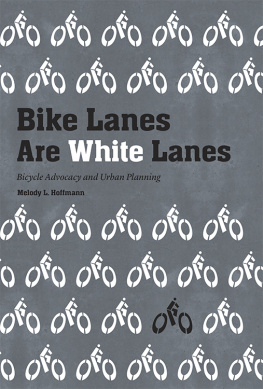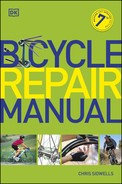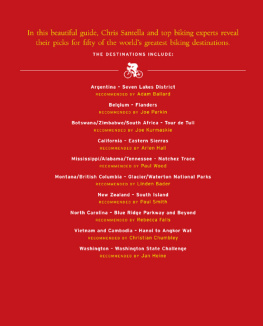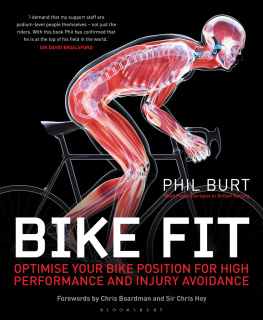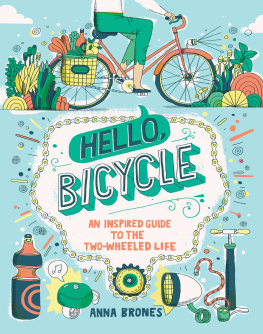THE
URBAN BIKING
HANDBOOK
The DIY Guide to Building, Rebuilding, Tinkering with, and Repairing Your Bicycle for City Living
CHARLES HAINE

2011 by Rockport Publishers
All rights reserved. No part of this book may be reproduced in any form without written permission of the copyright owners. All images in this book have been reproduced with the knowledge and prior consent of the artists concerned, and no responsibility is accepted by the producer, publisher, or printer for any infringement of copyright or otherwise, arising from the contents of this publication. Every effort has been made to ensure that credits accurately comply with information supplied. We apologize for any inaccuracies that may have occurred and will resolve inaccurate or missing information in a subsequent reprinting of the book.
First published in the United States of America by
Quarry Books, a member of
Quayside Publishing Group
100 Cummings Center
Suite 406-L
Beverly, Massachusetts 01915-6101
Telephone: (978) 282-9590
Fax: (978) 283-2742
www.quarrybooks.com
Digital edition: 978-1-61060-218-1
Soft cover edition: 978-1-59253-695-5
Library of Congress Cataloging-in-Publication
Data Haine, Charles.
The urban biking handbook : the DIY guide to building, rebuilding, tinkering with, and repairing your bicycle for city living / Charles Haine.
p. cm.
ISBN-13: 978-1-59253-695-5 (pbk.)
ISBN-10: 1-59253-695-6 ()
1. CyclingHandbooks, manuals, etc. 2. City trafficHandbooks, manuals, etc. 3. Bicycles Maintenance and repairHandbooks, manuals, etc. I. Title.
GV1043.7.H25 2011
796.6dc22
2011005061
ISBN-13: 978-1-59253-695-5
ISBN-10: 1-59253-695-6
10 9 8 7 6 5 4 3 2 1
Design: Traffic Design Consultants
Production: Claire MacMaster, barefoot art graphic design
Illustrations: Mario Ferro
Photography: Charles Haine and Drew Bienemann, except for the following: Adam Aufdencamp:
Printed in China
DEDICATTION
To my parents for getting me a bicycle for Christmas when I was 6the best Christmas gift ever.
To every mechanic and cycling guru who has had the patience to teach me everything Im lucky enough to have learned.
To all the folks at the Bicycle Co-op in Oberlin, Ohio, and the Bicycle Kitchen in Los Angeles, California, whove made my life so much richer.
CONTENTS

INTRODUCTION: WHY RIDE BIKES?
We are currently in the middle of a cycling renaissance. In the last few years the do-it-together (DIT) bicycle community and urban cycling have exploded. All kinds of people are riding their bikes for an increasing number of their everyday tasks.

In Los Angeles alone, a city not known for cycling even a decade ago, there are now monthly rides that attract thousands of cyclists riding through the day and night, and a group ride of one sort or another nearly every night of the month. All over the world masses of people are taking to two wheels and powering themselves through their cities like never before.
People are taking an interest in not only owning bikes but also fixing and customizing them themselves. Im not a very good mechanic is probably the thing I hear most often when teaching people how to fix bicycles, as if mechanical skill is something were born with, like good eyesight or red hair. For years Ive volunteered at bicycle education spaces and Ive observed that anyone who is interested in learning how to build or fix a bike is able to accomplish her goals. Sometimes it takes longer than we planned, and sometimes the parts arent immediately available, and often we get really greasy, but it turns out that bicycles are simple to fix.
Once you learn how to fix your own bicycle, two things are likely to happen:
Youll discover that most things are easy to repair yourself with a simple set of tools.
Youll find you love your bike more.
The time it takes and the understanding you get from building and repairing your own bicycle creates a bond that lasts. This book can help you learn the basics of how to pick out a good new or used bicycle and fix it up or maintain it yourself. Its mechanical sections are not intended to be exhaustive; there are many books and online resources that can help you rebuild your 3-speed Sturmey-Archer hub or reface your bottom bracket. (Not to mention that its possible to spend a decade riding and fixing bikes without having to do such tasks.)
This book is designed as a primer for urban cycling and basic bicycle repair. Fixing bikes and the community of people I have found who also love teaching people about the bicycle have enriched my life in many ways, and I hope you are able to get some of the joy Ive found on two wheels.
The bicycle is our first means of escape. As children we are completely dependent on our parents or the limitations of where we can reasonably walk to get where we want to go. Then, one magical day, we are granted freedom on two wheels: a bicycle.
The bicycle takes basic human power and augments it, expanding our range of travel. All of a sudden we are no longer limited by our city block or neighborhood; we can go to the next neighborhood over, or even out of town, all under our own power.
As teenagers, we get our drivers license and maybe a secondhand car, and our world opens up even wider, to nearby towns and cities, to work and play opportunities, even to dating people who live farther away. But some of us never transition from the bicycle to the car. And for those of us who do, many go back to the bicycle as our primary transportation.
Cycling, especially cycling in the city, offers everything you might need for transportation. It has a very small carbon footprint, since the only fuel you need to run it is the food you put in your belly and the energy used to make and ship the bike. You never have to look very long for a parking spot, no matter how hip or populous the neighborhood. Instead of sitting in your car in traffic, you whiz right by everyone, and, in many cities, arrive before you would if you had taken a car. When combined with the good public transit systems that exist in virtually every metropolis, bicycling puts the whole city at your command.
Cycling also gives you a feeling of connection to the world around you that is seldom felt in a car. When riding down the street, if you see a friend in a caf you can easily stop and chat in seconds, fostering the sort of accidental social contact that helps cities thrive. Not only would you have to look for parking for a car or motorcycle, but you would also likely be going by too quickly to even notice your friend in the caf window at all. You also find yourself out in the open air, noticing and appreciating things about your community you wouldnt otherwise see. Gatherings of cyclists at stoplights frequently open up conversations and new friendships.
In the past few decades, dedicated communities of urban cyclists have formed around the globe where folks come together through a common love of cycling as a way of life, not simply a form of recreation.
Charles Haine



